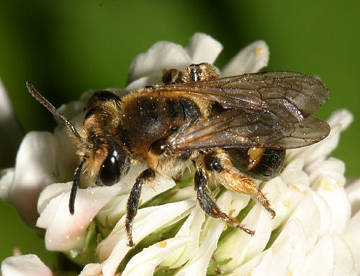

PHOTO COURTESY OF Tom Murray
A mining bee (Andrena wilkella), one of the many wild solitary bees in Massachusetts
March 9, 2018, Page A10
NATURE NOTES
By Annie Reid
Westborough Community Land Trust
Get to know the pollinators
Spring is right around the corner, plants will soon green up, grow, and bloom, and Martha Gach of Mass Audubon’s nearby Broad Meadow Brook sanctuary (off Rt. 20 just over the Worcester line) came to Westborough to share her knowledge and enthusiasm for the pollinators that are so vital to much of plant life. By extension, pollinators are also vital to humans, because we depend on plants and their pollinators for food and for the ecosystems that surround us. It’s said that we should thank a pollinator for every third bite of food that we eat.
Who are the pollinators? In her talk, Martha noted that in Massachusetts the main pollinators are one bird (the ruby-throated hummingbird), about 100 different butterflies, and many more bees. Also, some beetles, flies, and other insects are also pollinators here. In the southwestern U.S. deserts and the tropics, many species of bats pollinate flowers, but our New England bats don’t do so. Pollinators visit flowers for nectar, and in the process pick up pollen on their bodies from one flower and transfer it to the next, furthering plant reproduction, healthy cross-pollination, and fruit production.
Most of us are familiar with honeybees, which are actually non-native (from Europe), and bumblebees, most of which are native. But did you know that we also have many other species of wild bees? They are known as solitary bees because they don’t live cooperatively in hives or social colonies the way honeybees and bumblebees do.
Solitary bees are gentle and nest singly, typically in holes that they dig the ground or in dead wood, plants stems, or logs. Mining bees and sweat bees (often colored metallic blue or green) nest in the ground. Mason bees, leaf-cutter bees, and cellophane bees line their egg chambers with natural materials. Mason bees make their egg chambers inside plant stems and line them with mud. Leaf-cutter bees line egg chambers with pieces of leaves. Cellophane bees make a liquid that turns into a cellophane-like substance to line their egg chambers in the ground. Carpenter bees nest in wood that has started to decay.
Do you have to worry about getting stung by these various wild bees? In general, no. They possess stingers, but they are not aggressive because they don’t have a communal hive or nest to protect.
Is every insect that looks like a bee really a bee? Again, the answer is no. Many flies, for example, are mimics that look like bees – and pollinate flowers – but are not bees and can’t sting. One way to tell the difference is to look carefully at their wings. Bees have four wings (two on each side), but flies have only two.
How can we help pollinators, especially our many native bees? Martha noted that they need food (nectar-producing flowers), water, places for their nurseries (where they can lay eggs and raise their young), and safe spaces where they can take shelter.
We can support pollinators by: 1) leaving some “messy” areas in our gardens where they can live (leftover leaves and stems, no mulch); 2) leaving some bare spots on the ground; 3) planting native plants (for nectar and for the eggs and caterpillars of various butterflies); and 4) especially, by not using chemicals in the garden or on lawns. Pesticides such as the widely sold neonicotinoids (“neonics”) are toxic to insect nervous systems. They harm or kill pollinators, in addition to the aphids and other insect pests that they target.
For more information, you can watch a video of Martha’s talk, thanks to Westborough TV, at:
http://71.248.188.158/vod/7648-Westborough-Community-Land-Trust-presents-Pollina-High-v1.mp4